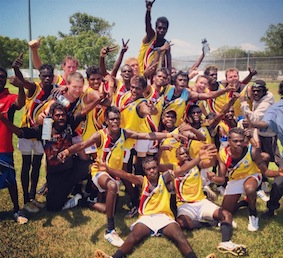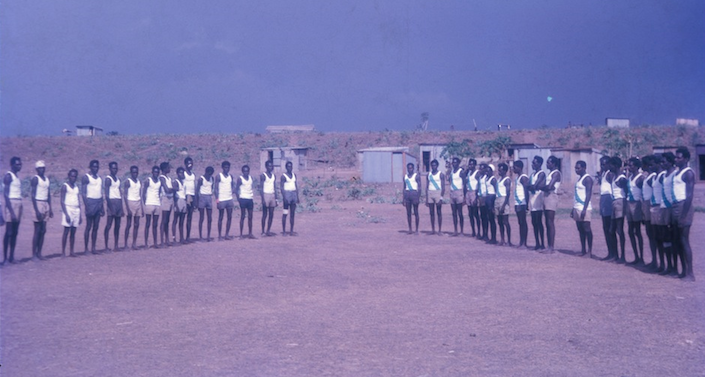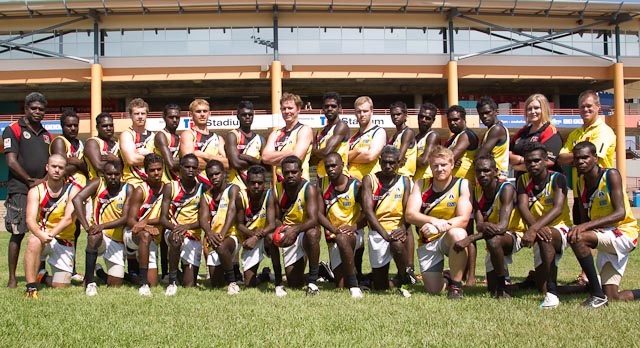The True Magic of Wadeye
- Friday, April 26 2013 @ 02:38 am ACST
- Contributed by: Wesley Hull
- Views: 10,311


“Football has a long history in the community of Wadeye that dates back to the start of the Mission in June of 1935. The families of Wadeye had their own traditional sport that involved throwing a man-made paperbark ball covered in kangaroo hide. However when the Mission arrived, Father Docherty (or Yile Ngala as he is referred to by the locals) and some indigenous men from Darwin, introduced the football and the art of kicking. From that point on AFL has been the game of choice for everyone in the community.”
This introduction to the footballing heritage of the Wadeye community is provided by Katrina Bushby, the Club Development Manager at the Wadeye Magic Football Club, in one of the many remote parts of the Northern Territory. Katrina’s keen insight into the development of the game is a great starting point for one of the more remarkable footy stories in Australia.
Wadeye, formerly known as Port Keats, is in the far north-west corner of the Northern Territory on the western boundary of the Daly River Reserve, near Hyland Bay. It is 230 kilometres by air from Darwin, and further by road – assuming the roads are open, as they are often cut by flooding during the “wet” season.
In tracing the history of the game in Wadeye, it is interesting to consider the development of the community. The Aboriginal family groups who lived off the land in the Wadeye and nearby Werntek Nganayi lived by fishing and hunting. Long before their first contact with white man they traded with the Macassans from Indonesia for beche-de-mer (sea cucumber). It was 1935, however, when Father Docherty arrived and started his mission at Werntek Nganayi, later moving it to the current site at Wadeye.
But the game of Australian Rules football has grown within this environment, and lately prospered. According to Katrina, “It is impossible to walk down the main street in town and not see an avid fan wearing a supporter’s guernsey. Everybody has a friend or family member on the team so it is a real place of pride. The local council has even gone as far as painting a giant Wadeye Magic logo on the side of the Sport and Recreation Hall that is impossible to miss. Local indigenous bands have even written songs about the football team that range from acoustic ballads to heavy metal anthems. The team really is something special.”
Interestingly, the jumper worn by Wadeye players is a measure of the community pride. According to Clare Rawlinson and Charlie King, in an article for the ABC, the design was “chosen after students and members of the community were invited to make designs. The jersey depicts a tribesman holding a spear and uses the traditional Aboriginal flag colours of red, black and yellow.”
But this image is a far cry from the Wadeye of the previous decade. This indigenous community, the largest in the Northern Territory with a population of close to 3000 people, was almost torn apart by violence, gang warfare and despair. The Age newspaper stated in 2006 that “gang violence has turned the remote indigenous community of Wadeye into a war zone.” Varying degrees of action and inaction over the years seemed to have little or no impact on the escalation in “anti-social behaviour”, as it was simplistically described in some government circles. That description missed the point a little by believing the issue was behavioural, not acknowledging the depth of gang and clan divisions which were tearing the community apart and driving people’s emotions, beliefs, lifestyles and behaviour.
But then Australian Government youth funding grants, along with corporate support and local sponsorship, became available from 2007 and the AFLNT was able to direct that money through the AFL Remote Regional Development Program to Wadeye. This same program has since funded the employment of AFLNT Development Officers in other remote Northern Territory communities such as Maningrida, Gapuwiyak, Galiwinku, Lajamanu, Groote Eylandt, Ngukurr and Hermannsburg.
And this, in turn, led to the birth of the Wadeye Magic. The local competition that had been running for years, and subject to the ebbs and flows of community needs and situations, was now able to unite behind a single entity. The Wadeye Magic were admitted into the NTFL competition – and made a powerful statement immediately, defeating the Palmerston Magpies by 78 points.
The magic of Wadeye had arrived.
Tony Frawley, AFLNT CEO, once said in an ABC interview. "people say how could you get a team from Wadeye in [the NTFL] and we’ve done it." Presumably this comment includes not only the efforts of the AFLNT, but also the community of Wadeye who came together to make something special happen.
Katrina Bushby looks at the current position for Wadeye Magic this way. "We currently have 6 local teams that make up the Wadeye Football League and it is from these teams that our Wadeye Magic boys are selected to compete in the NTFL. Although we have limited positions on the team we can have anywhere between 30-50 men training at a time during season.
"Wadeye has had a turbulent past, but the Wadeye Magic gives the community and all of the different families the opportunity to come together as one for a positive cause. To be on the team the players have to either be employed, at school or taking part in some form of training. They must also undergo regular health checks and take part in educational workshops. This criteria was established to promote personal development and the benefits of healthy lifestyle choices. It also ensures that the football club is giving back to the community as most of our sponsors are internal."
The future is certainly looking rosier than it might have done 5 years ago, but with the government committing to an additional 10 years of funding to the programs which assisted this change, this future has the chance to grow further.
But Katrina still adds a note of caution. “Our most prominent threat at the moment is sponsorship. We have had two incredibly successful half season trials, however this year we [will] aim for our first full season and to do so will require a significant amount of financial support. Due to our remote location, flying the entire team to Darwin and back on a weekly basis is an expensive task and unfortunately due to the conditions during the wet season we are unable to drive due to the flooding of the Daly River.”
But if the Wadeye community can find solutions to these challenges with the same determination and zeal as they have shown to reunite their home, then anything in their future is possible.
Wadeye may not have pulled a rabbit out of the hat. But they have replaced despair with hope, confusion with confidence, fear with optimism and a fractured community with unity.
And that’s just… Magic.
Wadeye football in the 1950s
The Wadeye Magic in the modern era


 RSS news
RSS news Twitter
Twitter Facebook
Facebook